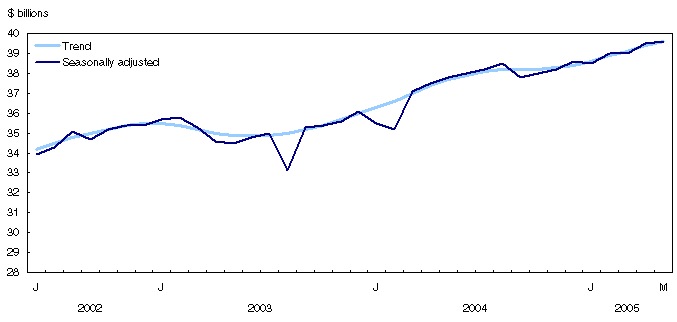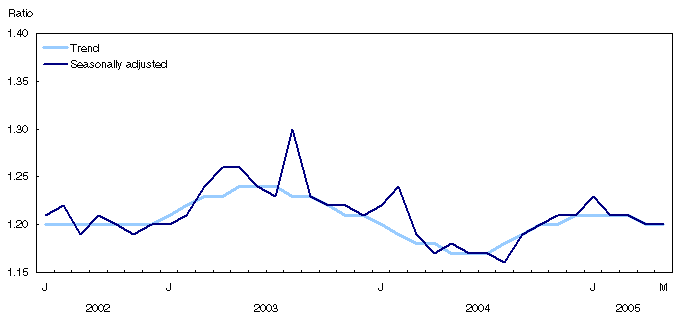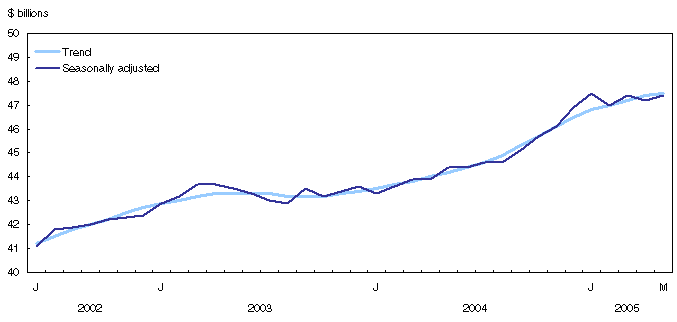
















 |
|
 |                |
Information identified as archived is provided for reference, research or recordkeeping purposes. It is not subject to the Government of Canada Web Standards and has not been altered or updated since it was archived. Please "contact us" to request a format other than those available.
| Wholesale trade
May 2005 Analysis — May 2005 Wholesale sales rose for the fourth consecutive month in May, edging up 0.2% after jumping 1.2% in April. Most of the growth in May was attributable to increased demand for "other products" (mainly chemicals and other farm supplies) and continuing strong demand for machinery and electronic equipment among businesses. The increase in May was partly dampened by lower wholesale sales of building materials. Chart 1

In May, four of the seven sectors, with sales representing 67% of total sales, posted gains. The largest increases were in the machinery and electronic equipment sector (+2.4%) and the "other products" category (+1.5%). The steepest declines were in farm products (-3.5%) and building materials (-3.0%). In constant dollars, wholesale sales rose 0.2% in May. Since September 2003, total wholesale sales have generally been rising, with most trade groups showing strength. Previously, lower sales of motor vehicles were the main reason for the decline that began in April 2003. Strong sales in the machinery and electronic equipment sector Wholesale sales in the machinery and electronic equipment sector posted their fourth increase in five months, rising 2.4% in May. Most of the growth was attributable to increased demand for machinery and equipment (+3.8%), especially farm machinery. Since September 2003, wholesalers in this group have benefited from increased business spending on capital goods. With the rise of the Canadian dollar, these goods, which are largely imported from the United States, have become less costly for Canadian purchasers. Most of the machinery and tools purchased come from the United States. Chart 2

Wholesalers of computers and electronic equipment sold $2.6 billion worth of goods and services in May, up 1.8% from April. Unlike machinery and equipment, this group has not enjoyed steady growth. One consequence of the bursting of the technology bubble in 2000 was that business spending on electronic equipment stalled. This phenomenon, which began in 2001, continues to affect wholesalers in this industry. Sales of "other products" continue to grow Following a 7.4% rise in April, sales in the "other products" category grew 1.5% in May. Wholesalers of chemicals and other farm supplies were again the main source of this growth. Some components posted relatively high prices in April and May, which contributed to this growth. Since September 2003, sales in the "other products" category, while unstable, have generally been rising on the strength of global demand. That demand has been especially favourable for wholesalers in Saskatchewan. Sales of building materials fall Wholesale sales of lumber and millwork fell 4.7% in May, the third drop in four months. Despite that drop, sales in this sector remained 7.6% higher than in May 2004. The drop resulted in part from the weakness of residential building activity. According to the Canada Mortgage and Housing Corporation, the number of housing starts fell 9.9% in the first quarter of 2005. Meanwhile, lumber exports fell 4.0% in May. Wholesalers are responsible for roughly 25% of the exports of these types of goods. Since March, US housing starts have weakened after reaching a 20-year peak in the first two months of the year. Approximately one-third of the lumber consumed in the United States comes from Canada. Wholesale sales of building supplies also declined in May (-3.3%). This was the first drop in six months. From January to May, sales of this group were up 11.3% compared to the same period of 2004. This group is dependent on the renovation market, which continues to boom. In the first quarter of 2005, $6.2 billion was spent on renovations, up 10.8% from the $5.6 billion spent in the first quarter of 2004. Western provinces continue to enjoy growth As in previous months, wholesalers in Western Canada continued to lead the growth of wholesale sales. All of the western provinces posted higher wholesale sales in May except Manitoba, where sales fell 3.2% following a robust 9.7% increase in April. Saskatchewan wholesalers posted higher sales for the third time in four months in May, advancing 3.2%. The increase was attributable to the "other products" category and the machinery and equipment group. Sales were up 22.4% from January to May compared to the same period in 2004, the strongest increase among the provinces. A surge in resource prices helped boost wholesale sales in Saskatchewan. Saskatchewan wholesalers have generally posted rising sales since March 2004, following a period of contraction that began in March 2003. British Columbia wholesalers also registered a third advance in four months, with their sales increasing 1.5% to $4.0 billion. Increases were reported in many groups, notably "other products" (such as paper, paper products and disposable plastic products) and motor vehicles. Since October 2003, British Columbia's total wholesale sales have generally been rising. Following a 1.1% decline recorded in April, Quebec wholesale sales grew 0.9% in May. This gain was mainly attributable to wholesale sales of "other products" and motor vehicles. Despite the increase in May, Quebec wholesale sales have generally been stable since the start of the year, following a period of strong growth that began in October 2003. Wholesale sales slipped 0.3% in Ontario, only partly offsetting the strong 2.0% increase in April. May's drop was mainly attributable to building materials, a sector which had experienced strong growth the previous month. Inventories up slightly Inventories edged up 0.4% in May after declining for only the second time in eight months in April (-0.3%). The trend in total inventories has generally been upward since November 2003, after a period of five months in which wholesalers had reduced their inventories. The inventory-to-sales ratio remained essentially unchanged in May at 1.20. This ratio has generally remained stable since October 2004, following a downward period that began in October 2003. Chart 3

|
|
|
|